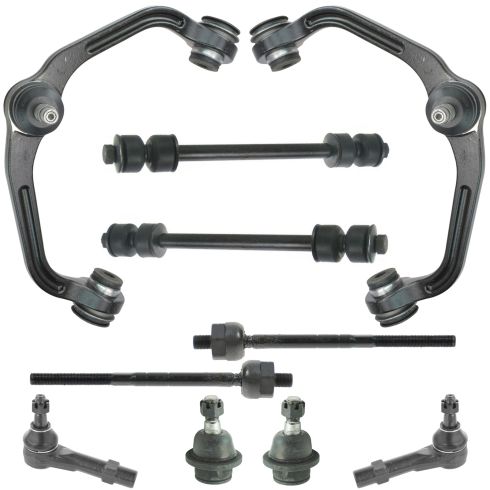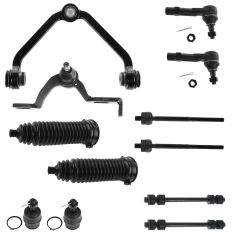1ASFK00855-Ford Mazda Front 10 Piece Steering & Suspension Kit TRQ PSA58697

Replaces
2001 Mazda B3000 Truck SE Rear Wheel Drive Front 10 Piece Steering & Suspension Kit TRQ PSA58697

Product Reviews
Loading reviews
4.50/ 5.0
10
10 reviews
Front suspension kit
January 31, 2017
Great parts for the price. Straight forward replacement and if you need help they have a video available.
Awesome
April 25, 2017
Everything was correct and good quality!! Would reccomend this to anyone great deal saved a lot of money
Good fit
June 19, 2017
Everything seems to be working great. They make the ride smooth again. Only issue is the grease fitting on the bottom ball joint. You can't leave them in bc they hit the axle. Just grease them up, take them out and plug the whole with a flat screw
Good kit, fast shipping
September 27, 2017
Got the kit fast but when I open it not all the ball joints come with grease fittings. I got two different types of upper ball joints. One with the grease fitting, which I like and wanted and the other with out. Then the steering rack putter ball joints didn't have any grease fittings like there picture. I called the customer service and they told be they have both types and it doesn't matter they both work. I don't like to mix up brands and types but I had no choice but to put them on because I had already taken all my parts off and was waiting on ups to brings the new ones that day. Put them on and they seem to be doing good on a 350 mile road trip I took.
1a auto is my go to place to order parts
September 4, 2018
I ordered several times from 1a auto and Ive not been disappointed yet always helpful and if your not sure about something pick up the phone and a representative will be gladly to help.
Awesome!
December 20, 2018
I was amazed at the delivery time. Must faster than they originally told me. Parts are high quality and everything was correct. I will definitely order from here again and again.
Lower front control arm part kit
April 12, 2019
A1 parts prices are unbelievable. I Have already recommended the company to all my friends
Price was affordable
September 15, 2019
Great Quality parts that are very affordable way better den those auto parts stores I recommend 1aauto delivery was earlier den I expected
Great parts!!
November 12, 2019
Parts were exactly as advertised. Good quality, fitment was perfect.
January 31, 2022
Box all broken on this shipment also .
Customer Q&A
Do the ball joints have grease fittings?
April 17, 2016
10
No
April 18, 2016
Brian F
Is this kit for torsion bar or coil spring front suspension?
May 7, 2019
10
Please review the 'Vehicle Fit' tab on the listing to see which vehicles are specific to suspension type.
May 7, 2019
Andra M
Is this for coil springs?
March 12, 2020
10
Thank you for your inquiry. Yes, these parts are compatible on vehicles with or without the coil spring suspension. However, there are further specifications that would need to be verified to confirm the fit. If you are able to provide your VIN we can see if this kit will be a direct replacement for you application. Please let us know if you have any further questions, thank you!
March 12, 2020
Jessica D
10
Yes, this kit works with Ranger/B-series trucks with coil spring front suspensions.
March 14, 2020
Dan C
Is this for coil spring?
March 12, 2020
10
Thanks for your inquiry. This part is will be able to work for vehicles that came with the coil spring suspension. Please do not hesitate to contact us with any further questions.
March 12, 2020
Emma F
Mazda is a registered trademark of Mazda Motor Corporation. 1A Auto is not affiliated with or sponsored by Mazda or Mazda Motor Corporation.
See all trademarks.

















